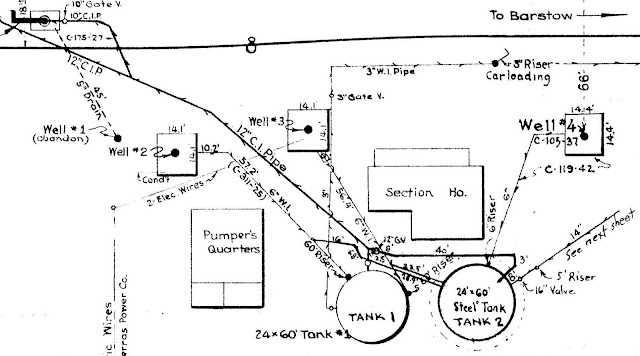Our Victorville motive power this time is a very rare one, as UP's 4-12-2 #9000 only came through Victorville on one occasion, in 1956. And thanks to Bill Messecar, I can report that a new track and a new building (a section house) have been added to my layout.
Let's begin with the Union Pacific 4-12-2 #9000, which came west on May 3, 1956, headed for display at the rail museum in Pomona. UP had acquired 88 of these very long wheelbase locos with three cylinders during 1926-1930 and numbered them in the 9000 Class. They were upgraded over the years, but they stayed on the flatlands to avoid the sharp curves in the mountains.
But on May 3, 1956, #9000 (a coal-burner) came west with just a UP caboose behind it. Because of this rare event, there were quite a few photos shot of this loco as it approached and then crossed Cajon Pass, as we shall see.
Here's a color photo of it as it came racing through Oro Grande on its way to Victorville:
And here we see it coming through Victorville, with a rare view of an old passenger carbody in the background, where the swing brakemen from freight trains rested:
When it got to Summit, it had to creep around the sharp curve west of the depot area, while the trainmen watched for any sign that it was derailing:
Here's another view of that same, tense moment:
Chard Walker got a shot of #9000 as it passed the Cajon depot:
Here's a good side view as it continues downhill, between Blue Cut and Keenbrook, also shot by Chard Walker:
Finally, Phillips Kauke got a shot of #9000 as it descended through Devore:
Here's a view sometime later, after it went on display at the Rail Giants museum in Pomona, CA, where UP Big Boy #4014 also used to reside:
That was the only time that a UP 4-12-2 ever crossed Cajon Pass, but since the 1956 date falls within my time period of 1946-1956, I can set my time machine to that date on occasion to recreate that special event as it went through Victorville.
There have been a number of HO models of the 9000 Class in various versions. I chose the MTH version, simply because it was less expensive and it came numbered as #9000:
Broadway Limited made a brass-hybrid model of those locos:
And another brass model came from Key:
Now let's turn our attention to various bits of progress on my layout.
Regarding the Texaco gas station that Don Hubbard has built for the Lower Narrows scene, I've been buying some vehicles for him to place there -- an Oxford Diecast 1946 DeSoto Suburban with luggage on the roof, for parking beside the gas pumps, and a Woodland Scenics "Carburetor Chaos" panel truck with the hood open and with mechanics, for parking in front of the garage.
Bill Messecar has been working on scratch-building one of the section houses that were in front of the water tanks in Victorville. He's decided to build an entire diorama with all the nearby structures (two water tanks, two section houses, a shed, and three pumphouses with derricks), as shown in this partial map from the Water Service Records:
I estimated the size of the diorama to be 12" x 24". He wanted a full-scale drawing of the area, so I did the math and enlarged the Water Service map to 378% and taped the sheets together.
I also realized that I hadn't allowed enough space for this 12"-deep scene on my track plan, so I went back and erased E Street and moved it back another four inches (1/4" on the plan) to make room for Bill's diorama.
Last Friday morning Bill arrived with the Pumper's Quarters (later called the Track Supervisor's House) already scratch-built from the plans he drew! We placed this house, along with the two pumphouses with derricks that he had built previously, onto the diorama map that I had constructed:
Here's a view of the same buildings from the rear:
Then we worked together on laying a new staging track, which is called Track E4. It's part of the E yard, which already had its other three tracks in place, for storing diesel sets someday. Track E4 is for moving locos and cars on and off the layout, by connecting to a future cassette-loading area.
And Bill posed near the other end of Track E4, with a parallel-track tool in hand (he liked using the Bachmann adjustable parallel track tools):
I still need to file down some loose ties and slide them under the rail joiner areas, and I'll need to wire this new track.



















No comments:
Post a Comment